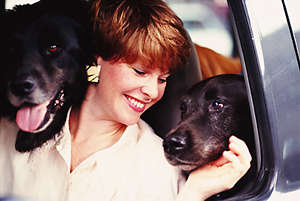
 |
|
 Is your pet comfortable and happy when traveling? Some animals, like many people, only like familiar surroundings. A car-sick, unhappy animal can make a trip miserable. Ill or physically impaired dogs and cats cannot withstand the rigors of travel. If this is the case, leave your pet with a relative or a good boarding kennel. Along the way of the trip, be considerate, and find out in advance if the pet is welcome. Check first about pets with friends, hotels, motels, parks, and campgrounds. Don't permit the animal to sleep on beds, chairs, or bedspreads. If the animal must be left alone in the room, place a "Do Not Disturb" sign on the door and inform the maid or front desk. Be sure your pet wears a collar with complete identification and a license tag. Have a rabies vaccination certificate if you will cross state or international borders. Be prepared to present a health certificate, especially if you travel to Canada or Mexico. Be sure to bring your pet's favorite food, toy(s), and dishes. For Travel By Air You can minimize the changes of an unpleasant experience by following a few guidelines. Regulations state that dogs and cats must be at least 8 weeks old and weaned at least 5 days before flying. Current health and rabies vaccination certificates will be required. Contact the airline well in advance to check regulations and services, and to make reservations. Try to book a direct, midweek flight or one with a minimum of stops. During warmer periods reduce risk of overheating by choosing early morning or late evening flights. Be at the airport early, exercise your pet, place it in a cage yourself, and pick up your animal promptly upon arrival. Don't take leashed animals on escalators. The proper cage, available from most airlines or pet shops, should have the following features:
For Travel By Car If your pet is not accustomed to the car, take it for a few short rides before the trip. Your cat might ride better in a carrying case. Stick to your regular feeding routine and give the main meal at the end of the day or when you've reached your destination. It will be more convenient to feed dry food if the pet is used to it. Dispose of unused canned food unless it can be refrigerated. Take along a plastic jug of cold water to avoid possible stomach upset the first day. Give small portions of both food and water and plan to stop every two hours for exercise. And remember to include a leash in your travel kit. Grooming (bathing, combing, nail trim) before the trip will make the animal more comfortable. For Travel By Bus or Train Most states prohibit animals on buses, and recent rules now prohibit animals on trains. Exceptions are generally made for seeing-eye dogs accompanying blind persons. Inquire in advance with local carriers. For Camping With Pets Be careful, skunks, porcupines, snakes, and other creatures can bite or injure your pet. Therefore, keep your animal in sight and on a leash. Be considerate of other campers. For Post-Trip Examination A health examination following your trip should be considered to determine if any internal parasites (roundworms, hookworms, heartworms) or external parasites (ticks, fleas) were picked up in contaminated exercise or wooded areas. |
|
|